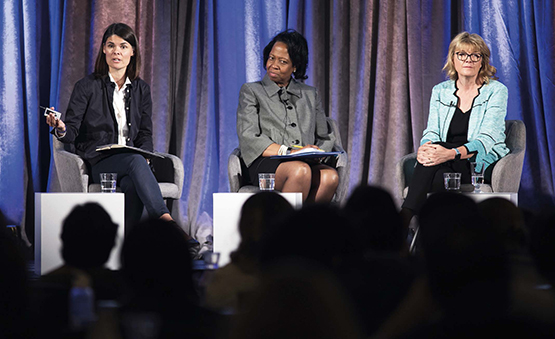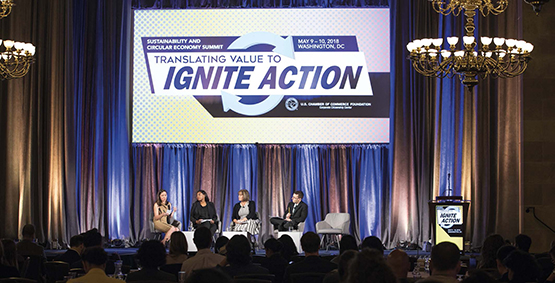What is the difference in the way Brussels and Washington D.C. see the circular economy? To get an answer one should have attended the Fourth Circular Economy Summit, organised by the powerful US Chamber of Commerce Foundation, and simply counted the amount of billion dollar corporations present. Big names such as Coca-Cola, AB-InBev, Lockeed Martin, Veolia, Lexus. The circular economy is a very interesting topic for big business. On the other hand, there were only a sparse number of associations registered, and the presence of public administration and government representatives was almost non-existent, and limited to a handful of people from the American Environmental Protection Agency (EPA). A far cry from the Circular Economy Stakeholder Summit in Brussels, that hosted many research bodies, IGOs, associations, European agencies, chambers of commerce and just a few big business representatives.
As early as 8.30 am, those registered crowded around the entrance of the Chamber of Commerce Foundation, near Lafayette square, and literally opposite the White House. Coffee galore and many young people. “For our company it is very important to carefully observe these new trends,” explains James R. Lee, a sustainability engineer for Lockheed Martin, a global aerospace security colossus.
“The circular economy is not a widespread term in the US, but companies, especially in the packaging sector, are learning fast,” says Scott Byrne, a Tetra Pak environment specialist. A delegate of a big Michigan-based company, who prefers to remain anonymous, reveals the political reasons behind the business world’s sudden interest in the circular economy: “In Washington, you better not talk about climate; on the other hand, the circular economy is a politically neutral expression that anyone can use.”
Meetings focused on how to achieve Sustainable Development Goals (SDGs), concentrating on Goal 12 (Responsible Consumption and Production Models) and how to communicate one’s “real circularity and sustainability.” “Communication is crucial,” explains Deborah Philips of the American Chemistry Council who applauds the arrival of the circular economy in the US, “it is a great opportunity for the American chemistry sector and for the packaging industry as a whole.”
According to Chris Walker, the North American Director of World Business Council for Sustainable Development (WBCSD), “The circular economy concept is still not popular in America because over here we have always talked about the efficient use of materials. Moreover, in Europe this concept entails a long-term environmental vision. In America, it focusses primarily on business opportunities linked to secondary raw materials. Not even five years ago it was still considered a topic for tree-hugging environmentalists. Today, the circular economy implies recognising how waste can be a business opportunity, with a value that must be identified.”
The EPA agrees and in an email it reasserts the importance of Sustainable materials management (SMM) through their entire lifecycle. The principles behind this approach are based on the efficient use of materials, emphasising the reduction of toxic elements used in materials, and resource management in line with current and future industrial requirements. Just by looking at the EPA’s 2017-2022 strategy on SMM, one can see many similarities between SMM and the circular economy.
“But, this is not enough,” explains Chris Walker to Renewable Matter, “we need to marry Europe’s unabridged vision of the circular economy.” This is the Chamber of Commerce’s objective and the reason behind organising the most important event on the circular economy in the US to date. Judging from attendance, interest has definitely increased.
When asked: “What do you think of the EU Circular Economy Package and its new plastic strategy?” attendees answer cautiously. In America, regulations are not very popular. However, they are discussed. Walker tells us that: “Having a paved playground would help greatly. The patchwork of state laws, all different from one another and often entailing serious economic losses, drives American companies crazy. Moreover, some States and counties do not have any legislation regulating separate waste collection. WBCSD does not usually suggest regulatory interventions, but in this case we need federal leadership.”
A position shared by other interviewees. If Europe becomes circular, it will be of paramount importance to harmonise the market for goods, in order to avoid trade barriers. “It will be the same as with vehicle emissions. [In the USA] 49 states had weak standards. On the other hand, California introduced very strict targets. However, given the importance of the Californian automotive market, at federal level, strict emission standards were adopted. Likewise, if Europe has an aggressive market approach, based on the circular economy, the US business world will follow such strict standards so as not to lose out on this market,” concludes Walker.
The EPA is also paying close attention to the model put forward by actors such as the Ellen MacArthur Foundation. This is clear from the fact that the US Operations Director Del Hudson was attending in person. “The intention of substantiating the sustainable management of materials is growing,” explains Cheryl Coleman, EPA’s Resource Conservation Director, from the stage. “Many states have introduced SMM in their programmes. Today, we are moving from an end-of-life waste management vision, towards the management of the entire lifecycle of a product. Particularly, in the paper and packaging sectors.” Industries, NPOs and public administration are implementing more and more lifecycle analysis strategies, zero-waste targets, sustainability strategies and SSM initiatives. Moreover, the EPA is always interested in knowing and sharing the most widespread initiatives and practices, especially in the field of Resource Efficiency (RE), as outlined in its SMM Strategic Plan.
 |
|
Freya Williams, Cheryl Coleman, Cindy Ortega. Ian Wagreich/©U.S. Chamber of Commerce
|
Cheryl Coleman’s speech paid particular attention to food waste, the number one material destined for American landfills and incinerators. Food waste amounts to 21% of municipal waste. In 2014, only 5.1% of over 38 million tonnes was used to produce energy or compost. The rest was sent to landfills. The US Department of Agriculture (USDA) estimates that more than one third of fruit and vegetables bought by Americans is thrown away. Reducing food waste alone would cut 20% of the total methane emissions produced by landfills. Not to mention that, in the US, 42 million people are at risk of food insecurity. “The American government aims at halving food waste by 2030,” says Coleman. “If Europe is succeeding, so can we.”
In the meantime, Europe is working to set foot in the USA, ready for the circular economy boom. There are droves of Dutch companies with their embassy delegate, Bart de Jong, in tow; representatives of Rabobank Group N.V. (the Utrecht banking colossus, which is very active in the circular economy panorama); and other Orange circular economy companies. “There is a lot of work to do and companies are trying to gain a competitive advantage,” says De Jong. “But, this does not mean the American corporate world might not learn fast. This would foil our competitive edge.”
 |
|
Ann Amstutz-Hayes, Audrey Lundy, Stacy Okonowsky, Scott Breen. Ian Wagreich/©U.S. Chamber of Commerce
|
Fourth Sustainability and Circular Economy Summit, www.uschamberfoundation.org/event/fourth-annual-sustainability-and-circular-economy-summit
U.S. EPA Sustainable Materials Management Program Strategic Plan, www.epa.gov/sites/production/files/2016-03/documents/smm_strategic_plan_october_2015.pdf


